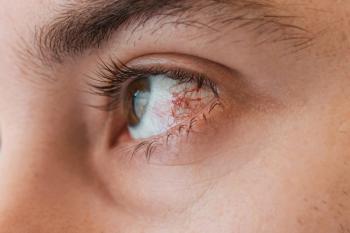
Simple tips help address diplopia
Diplopic patients can be enormous consumers of time in a busy practice.
Key Points
Minneapolis-St. Paul, MN-Diplopic patients can be enormous consumers of time in a busy practice, said Lisa P. Rovick, MHSc, CO, COMT. Don't be afraid to schedule these patients for late in the day to avoid throwing off your entire schedule. It takes savvy, well-trained staff to identify these patients when they contact the office.
According to Rovick, assistant professor and program director, orthoptics major, St. Catherine University, Minneapolis-St. Paul, MN, patients will appreciate your rescheduling of their appointment so you can spend the appropriate amount of time to accurately diagnose and treat their condition.
When a patient presents with diplopia, it's important to measure his or her eye alignment in gazes other than straight ahead. "Get these patients out of the phoropter and measure them in free space with cover testing," she said.
An Amsler grid is a simple tool to make the diagnosis, Rovick said. When patients see a "wavy" grid, it's a big clue that they may have an epiretinal membrane.
Even though you might be sure of your diagnosis in such cases, patients may need some convincing, Rovick continued. She suggested using the "lights on/lights off" test to help patients understand their condition.1 This test requires having a vision testing system in which the screen can reverse and show white letters on a black background, as well as the standard black letters on a white background.
Eliminate all sources of light in the room, including lights on equipment and from under the exam room door-except the screen for the visual acuity test. "If it's completely dark and the patient is looking at a white image on a black background, he or she will see a single image. Then, when you turn the lights on and the peripheral fusion kicks back in, the patient will see double," Rovick explained.
To help these patients deal with their diplopia, Rovick advised applying a filter-just a dot or a small strip of satin tape-to the center of the lens in their glasses. This will "fog out" the central vision in one eye and allow the patient to use his or her peripheral fusion.
"Once you've demonstrated this to patients, you can use this filter to basically help them pay attention to clearer image and ignore the blurry one," Rovick said. "But they have to believe you. You're not actually 'fixing' anything; you're helping them adjust to what they have to live with."
Use Fresnel press-on prisms on the lens over the non-dominant eye to let patients test out the use of prism in the real world.
"Rather than ordering a pair of glasses, having the patient try them, then remaking the glasses and changing the prisms again and again, let them 'test drive' the prism by using press-ons," Rovick said. "If the prism works, they don't even need to come back, you can simply mail them the prescription. If it doesn't work, they'll need to come back and you'll need to adjust it. But it avoids having a lot of remakes on glasses."
In addition, patients will not only appreciate the opportunity to try out the prism, they'll appreciate that you're sensitive to the fact that what happens in the office may be different than what happens in the real world.
Reference
1. De Pool ME, Campbell JP, Broome SO, Guyton DL. The dragged-fovea diplopia syndrome: clinical characteristics, diagnosis, and treatment. Ophthalmology. 112(8):1455-62.
FYI
Lisa P. Rovick, MHSc, CO, COMT
Phone: 65/90-7778
E-mail:
Ms. Rovick has no financial disclosures related to the subject matter.
Newsletter
Want more insights like this? Subscribe to Optometry Times and get clinical pearls and practice tips delivered straight to your inbox.



















































.png)


